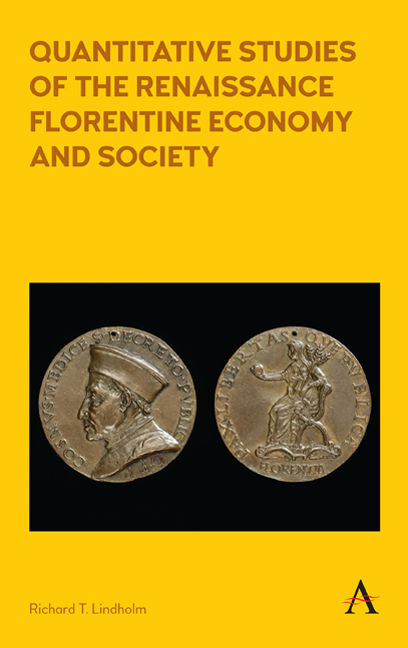Summary
This book uses quantitative methods to examine the economy and society of Renaissance Florence. An ongoing theme is the necessity to integrate these methods with the more commonly used qualitative methods such as legal history. These methods also consistently highlight the dynamism and flexibility that appear throughout the Florentine economy and society. This book is comprised of nine chapter-length studies organized into three parts based on the primary source materials, the type of analysis and the nature of the questions researched. Each study examines one aspect of Renaissance Florentine economy and society using a specific set of quantitative methods matched to the particular issues involved. The choices are meant to show the variation possible with quantitative methods. The topics were also chosen to show a breadth ranging from the Trecento to the Cinquecento, touch on the fields of economics, finance and sociology. The topics range widely, from an application of financial market data to explain plague mortality patterns to a demonstration of how a tax loophole subsidized the Renaissance Florentine architectural and artistic explosion. The quantitative approaches also vary widely and include description, estimation, hypothesis testing and measurement.
Part 1, titled “Risks and Returns,” shows the value of financial markets in the study of Florentine society. The risk, in Chapter 1, is dying from the plague, and the return, in Chapter 2, is the market yield of bonds. Both chapters substantially reinterpret previously used source material.
Chapter 1, “The Costs and Benefits of Running Away: Late Medieval Florentine Plague Mortality and Behavior,” uses financial market data to explore behavior during plague outbreaks in Renaissance Florence. The existing research on this subject is contradictory. On the one hand, the prevailing social historical opinion relies on aggregate death data to conclude that the plague was a purely summertime phenomenon. This conclusion necessarily excludes the bubonic plague as the primary cause of death. On the other hand, medical historical research and some social historical research settle on the bubonic plague as the main cause of death and reject the claim that the plague was exclusively virulent in summertime. The contradiction can be resolved by both conducting a closer examination of existing data and by applying a new set of data to the issue. The aggregate death data have a fundamental limitation.
- Type
- Chapter
- Information
- Publisher: Anthem PressPrint publication year: 2017



